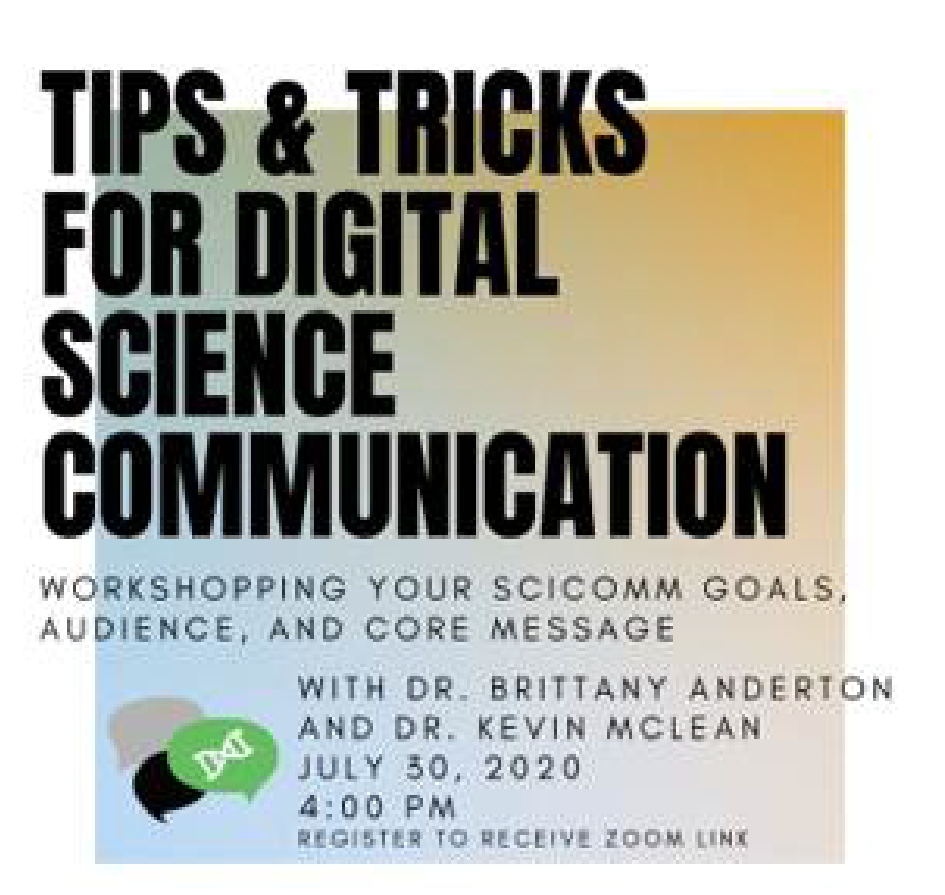Tips and Tricks for Digital Science Communication: Key Takeaways
 Our July 2020 event featured an engaging conversation with Drs. Pamela Ronald, Brittany Anderton and Kevin McLean about digital science communication.
Our July 2020 event featured an engaging conversation with Drs. Pamela Ronald, Brittany Anderton and Kevin McLean about digital science communication.
To prepare for the workshop, attendees watched a video produced by each of the speakers:
- Studying Coronaviruses: Vectors to Vaccines (producer: Kevin McLean)
- Cells of the Immune System (producer/creator: Brittany Anderton)
- The Case for Engineering Our Food (speaker: Pamela Ronald, TED Talk)
Participants were asked to think about the goal, audience and message of the videos, and were asked to develop a pitch for their own digital science communication project with these three points in mind.
Goal: What you (the creator) want the audience to think, feel, do or learn from your project.
Audience: Who is the project primarily aimed at? The more specific, the better.
Message: What is the key kernel or anchor point that you would like your audience to take from your project?
During the workshop, each of the speakers shared their approach to their video’s goal, audience and message. Dr. McLean described how these three key points shifted as the video developed and he collected more information on COVID-19. He emphasized being mindful of these three factors throughout the creative process.
“Good general messages may seem complicated but they’re actually simple when broken down.” – Dr. McLean
For Dr. Anderton’s video on immune cell types, she targeted first-year graduate students in immunology with the message of defining all the cell types they might encounter in their courses and how they relate to each other. When asked about how to gauge who makes up an audience, she said it is different for each circumstance. For instance, her video, while meant for first-year graduate students, is accessible through YouTube and therefore not just first-year graduate students may have watched it.
Dr. Ronald extensively workshopped her script with the TED committee. She highly recommended having a script and practicing it frequently, especially if the speaker gets nervous. She also recommended having real emotional examples to connect with the audience, instead of something artificial like an awkwardly delivered joke, if jokes are not natural to the speaker.
“Be authentic — content will resonate better in your own voice.” – Dr. Ronald
After we learned more about the speakers’ approaches to their content, attendees got the opportunity to workshop their own goals, audiences and messages with a partner.
For instance, here’s my pre-workshop project idea:
Goal: Produce and record a short explanation of the lab’s research using infographics.
Audience: Family, friends, students.
Core Message: Zebrafish gonads can reveal a lot of information about gonad development and sex determination that can be useful in a variety of applications.
My pitch received a lot of feedback. First, my goal doesn’t make the audience think, feel or do anything; instead, I want them to learn something about the research. My message also is too broad. My partner and I came up with the idea to break down the project into smaller segments with well-defined messages: one video introducing zebrafish as a model organism; one video introducing the sex determination project, etc. Here’s an updated version:
Goal: Learn about the research in the lab.
Audience: Nonexperts with a basic biology background.
Core Message: zebrafish are great models for human disease.
The goal, audience and message points of this workshop are central to the development of effective science communication, and keeping them in mind will help us create more impactful projects. It was really helpful to hear feedback from experts in the field.
“I liked hearing about the different approaches to science communication through digital media, and how their methodology differed when making different types of videos.” – workshop participant
Dr. Ronald is a Distinguished Professor in the Department of Plant Pathology and the UC Davis Genome Center. She serves as the Faculty Director of the Institute of Food and Agricultural Literacy. Dr. Anderton works at iBiology on the video production pipeline, leads the Young Scientist Seminar series and creates educational resources. Dr. McLean works on research talk videos and experiments with new content at iBiology. Both Dr. Anderton and Dr. McLean did their post-doctoral work at UC Davis.
Highlights from the Q&A:
How do you avoid image copyright?
Establish good practices early on when creating content. Use open access sources like Wikimedia creative commons or BioRender. There’s also a way to adjust image search settings in Google to find open access images. On the image result page, click Tools, then select “Labeled for noncommercial use” under the “Usage Rights” drop-down menu.
Thank you to Drs. Ronald, Anderton and McLean for their time and expertise. Have an idea for a digital science communication project? Pitch it to us at davissciencesays@gmail.com.
For further reading:
- NPR’s Project Blueprint - We suggest completing Sections 2 and 3 as a starting point.
- AAAS Communication Toolkit - We suggest answering the three questions in the “Before You Start” section.
- Audience & Purpose from SciTable - A short read to help you think about your audience and goal.
Sydney Wyatt is a PhD student at the University of California in Davis. For more content from the UC Davis science communication group "Science Says", follow us on Twitter @SciSays.

Comments